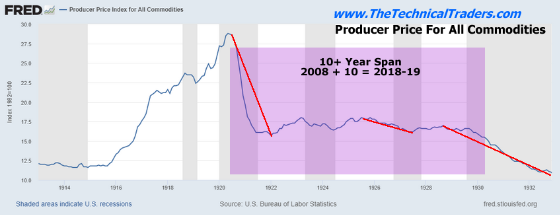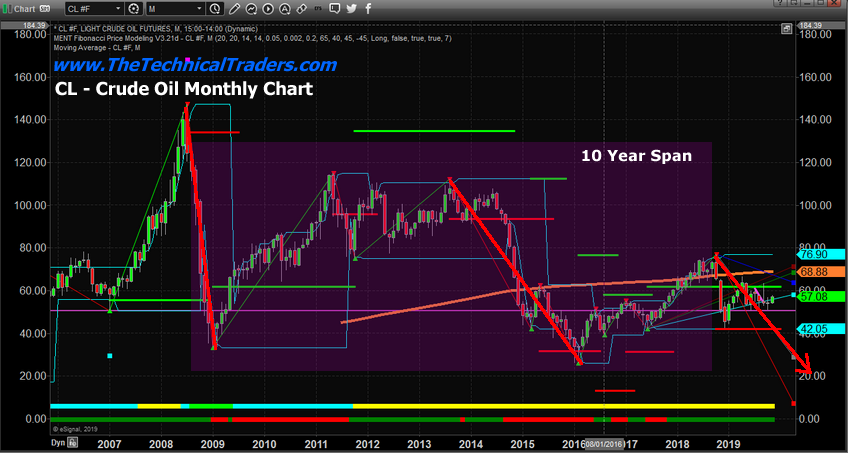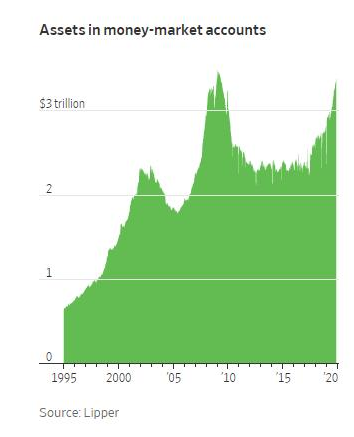In the first part of this research article, we shared our ADL predictive modeling research from July 10, 2019 where we suggested that oil prices would begin to collapse to levels near, or below, $40 throughout November and December of 2019. Our modeling system suggests that oil prices may continue lower well into early 2020 when the price is expected to target $25 to $30 in February~April 2020.

We believe that this type of global commodity price collapse, essentially a collapse in oil revenues for many nations, could present a very real crisis in our future. Most of the oil-producing nations rely on stable oil prices to supply much-needed revenues/income to fund current and future operations and essential services. If oil prices collapse to levels below $40, this decrease would represent a -40%, or more, collapse in oil revenues for these nations. If oil prices fall to levels below $30, this would represent a -55%, or more, decrease in expected revenues.
We believe the ADL predictive modeling systems results, if accurate, represent a real potential that the global capital and stock markets may experience a major crisis event before the end of 2020. This type of commodity collapse happened once before in history – nearly 10 years before the 1929 U.S. stock-market collapse. That slide in commodity prices continued into 1930 and beyond as an extended economic contraction pushed the U.S. into an economic depression.
Producer Price Index For All Commodities From 1914 To 1933
Take a look at these charts for comparison. The first is a chart of the Producer Price Index for All Commodities from 1914 to 1933. Pay close attention to how commodity prices collapsed in 1921, approximately 9 to 10 years before the U.S. stock-market peak (1929) and how commodities continued to slide lower. This collapse in commodity prices relates to the consumer, agriculture and industrial demand after WWI and setup a shift within the capital markets more focused on stock-market speculation. The period between 1923 and 1929 resulted in a complete shift in the capital markets when farms, agriculture and manufacturing levels decreased while urban areas and the stock market flourished – until it ended in 1929. (Source: eh.net/encyclopedia)

Now, take a look at this monthly crude oil chart, which highlights very similar types of price patterns over the span of about 10 years. This strangely similar chart, in combination with the similar set of circumstances related to farm, agriculture and manufacturing as well as the shift of capital towards speculation in the U.S./Global stock market may be setting up another type of 1929 stock market peak event.

Assets In Money Market Accounts
The shift in the capital markets is clearly seen in the following Assets-in-Money-Market-Accounts chart. One can clearly see that after the credit crisis in 2008-09, investors were not willing to participate in the money markets at levels prior to 2008. In fact, for the entire period of 2009 through 2017, global investors stayed away from money markets and only recently began pouring capital back into the markets in late 2017 – when confidence increased.
Yet the chart also shows a clear “shift” in capital engagement, which is similar to what happened in the late 1920s. At a time when manufacturing, agriculture and farm foreclosures were haunting the markets, investors poured capital into the stock market and speculative investments because these instruments were ripe with opportunity. The rally in the U.S. stock market in the late 1920s became an opportunity that no one could resist. Is the same thing happening right now? Has a capital shift taken place that has global investors bumbling their way into the U.S. stock market while trying to avoid/ignore obvious risks in local markets, manufacturing and the global economy?

Source: wsj.com
We believe the evidence is very clear for any investor willing to remove their “bubble goggles” and take a hard look at where we really are in the economic cycle. Unless something dramatic changes in relation to global economic growth, credit market expectations and consumer economic participation, it seems obvious that we are inching our way toward a global stock-market peak, just like we did in 1929.
Even if a trade deal between the U.S. and China were to happen today and all tariffs were eliminated, would this change anything or would it simply pour fuel onto the “capital shift” fire that is already taking place with speculation reaching frothy levels?
Skilled technical traders should pay close attention to oil prices and global economic factors while this “zombie-land melt-up” continues. We believe this is not a healthy rally in the U.S. stock market currently and more resembles what happened in the 1920s than anything we've seen in the past 80+ years.
In Part III of this research article, we'll highlight some of the recent economic news that helps to further identify the complexity that makes up the current global stock market zombie-land.
